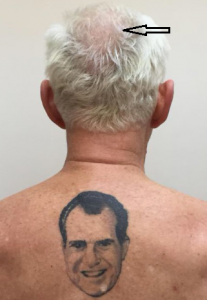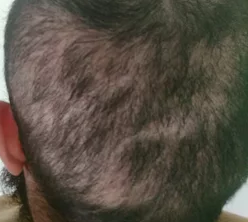I doubt that the dermaroller will harm your skin because it does not go very deep. Future transplants are much deeper in the scalp than the dermarollers.
No, finasteride can not cause thyroid problems.
There are over 500 clinics in Turkey bringing in over $1 billion per year. Of the 500+ clinics, over 90% are illegal without a doctor in the facility doing the surgery or the anesthesia. Many clinics perform multiple surgeries in a single large room, risking a cross-over of germs or even HIV from one patient to another. Production line hair transplants should be avoided as they are not bargains. Some of the good clinics with a good doctor do good work, but many of the clinics do variable quality work, many with infections reported by my European colleagues and deaths that are never reported. Just be careful and make sure that there is a doctor doing the surgery who has a good reputation.
If you didn’t have side effects before, while taking taking the drug, but came off the drug, would coming back on trigger any side effects or would you assume that no side effects would be the anticipated? Have you ever prescribed it to someone with mild NAFLD?
Yes, I have prescribed finasteride to people with non-alcoholic liver disease. If you didn’t have side effects before, going back on the drug now should also give you a similar experience.
These dents are the result of constant steroid injections which causes atrophy of the skin of the scalp. This can be treated by injecting fat cells into the dents to rebuild the scalp infrastructure. Hair transplants, if you need them, fix this problem nicely.
These are comments taken from a group of doctors who are concerned about patients who are sucked into ‘Black Market’ clinics or Black Market treatment.
“Black Market Hair Transplant” is companies making deceiving marketing such that the customer is offered a service/product that does not offer the benefits that are claimed.
Examples are: technicians doing surgery when it is marketed as the doctor doing it, artificial hair fibres that may have devastating complications which the patient is not made aware of, an FUE robot that claims to not have the disadvantage of human error while doing a much worse job than the average surgeon, LLT that claims to treat male pattern hair loss, PRP that claims to treat male pattern hair loss, PRP that claims to improve surgical results, the manual FUE punch marketed as less damaging to the tissue, FUE marketed as a scarless procedure, an FUE punch marketed as offering zero transections, an FUE machine marketed as the best option while the patient not being aware that the technicians are going to do the job etc.
Since regulations and even ethical standards vary significantly across the globe, it is okay to market anything that is legal within its region, provided that the customer knows what they are getting. If the patient knows for the price he is paying, he can only have technicians doing the surgery and this is what he wants then it is fine. On the other hand, if the patient is told the doctor will do the procedure and the patient is sedated during the surgery so he doesn’t see that the work is done by techs, then this is not okay.
If the patient is told that PRP is not an alternative to the traditional treatment of androgenic alopecia and that there may be some temporary benefits, then it is okay. However, if he is told that he doesn’t need to take medication and he can get his problem treated in a natural way, then this is not okay.
If the clinic says that the doctor prefers the manual punch then this is okay. On the contrary, if they tell the patient that they use a manual punch to prevent the damage that occurs with the micromotor, then this is not okay.
This is a common finding, something that I had with even more balding in the crown. Frontal hair loss and crown hair loss go hand-in-hand. He has a great hairline now, but at some time in the past, he had terrible pluggy hair transplants. He was fortunate to have had it repaired (and his white hair hides plugs nicely) so that the old plugs don’t show now.
I was relatively bald in the crown (balder than Mr. Stone). I received 2700 grafts over a 24 year period but I never lost hair in the front. His frontal hairline was clearly moved down and it is now in the normal position after his repair was done. I can tell this because I see the highest crease in his furrowed brow is less than one finger breadth below his hairline.



So I just got some blood work done to decide if I wanted to start finasteride. My main concern is developing gyno. Anything here that sticks out to anybody? Thanks.
Test -618 ng/dl (Ref:264-916)
Free test -15.2 pg/ml (Ref:9.3-26.5)
DHT -47 ng/dl (Ref:30-85)
Estrogen -72 pg/ml (Ref:40-115)
Estradiol -37.5 pg/ml (Ref:7.6-42.6)
Prolactin -19.9 ng/ml (Ref:4-15.2)
I’m also about to turn 21 in a few days and I’m in pretty good shape physically.
The tests are normal and that is what I would expect. You can’t predict Gynecomastia when taking finasteride and the blood tests will not tell you anything.
At your age, you might find that you could lose some of your existing native hair following the transplant. From the pictures, I see a low crown balding area which suggests that you might develop an advanced balding pattern in the long term. The use of the drug finasteride reduces this risk, but balding in men is progressive. Ask your doctor where your balding pattern might end up. Find out what your donor density is, so that some calculations of your reserve donor hair can be made now, before you start your transplants. Keep the hair transplants to the frontal area only, because if it goes into the crown, then you will be caught in a conundrum with patches of hair transplants in the front and in the crown will leaving you not normal looking. These steps will be the best approach to minimizing the risk of getting into multiple hair transplant surgeries as you lose more hair, which you should expect to happen. Your goal should be that just a single surgery will stand on its own and that is why I am suggesting that you only transplant the frontal area at this time.
The long term studies on finasteride show that the graphed out curve for balding on the drug looks like the people not on the drug, but there is a shift in the first two years as the hair growth is benefited from the drug. When the study was taken out 10 years, the slope of the curve continued downward.
Donald Trump had a Scalp Reduction surgery in the early 1990s (the surgical removal of his balding area), and may have had hair transplants producing a depleted donor area, strongly suggested by what we see in the video. The back of his head now appears bald which is most likely the result of many hair transplants procedures. The fact that he dyes his hair platinum blonde, again, strongly suggests that he had the old fashioned plugs, which is heavily softened by the blonde color. At the time his hair was worked on, few doctors were doing the surgery that we do today. I have been performing today’s technique since 1991 at about the same time as when he had his scalp reduction surgery. He has to keep his hair sprayed to keep it together, but obviously, the wind was worse than anticipated.
You need to sit down with a good doctor and get an examination that might predict your hair loss pattern. If that can be predicted (I often do this with the HAIRCHECK test), then your course after a single hair transplant might be anticipated. There is never certainty as I use the tools I have to give people the best assessment of their course over time. At our Monthly Open House events we have patients who had one or two hair transplant sessions and did not need anything after. If you come to one of these events, you can meet these patients one-on-one. The older you are when you start, the more predictable the risks, but if you wait, then you will learn to live with balding while you are younger, something most men who see me don’t want to do.
Considering a hair transplant but thinking about long-term commitments post-op from tressless
Take a look at the information on pumpkin seed oil which can be used if you want to try to stay away from traditional medications like minoxidil and finasteride.
https://www.karger.com/Article/FullText/492035
This is a 19 year old who has been told by everyone in the family that he is not balding. He has coarse hair and is as curly as it gets, so this could hide any balding from the naked eye. We performed a HAIRCHECK and he was right, he has lost 1/3rd of his hair volume in the crown. From these pictures, it is easy to see why no one believed him, but he knew and I confirmed it today. He elected to take finasteride to treat what he now knows is balding.




